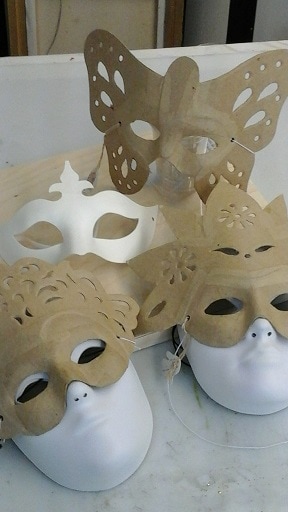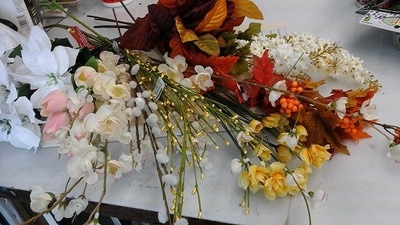I've had some ideas brewing in my brain for a new series of artworks and have been gathering the materials as I find them. The series is themed on the four seasons and will be four mixed media pieces on cradled wooden panels... each piece depicting one of our seasons.
I have gathered masks, two for each piece, that will be painted and appointed to personify the season; artificial flowers and leaves for each season; fabrics for backgrounds and other applications... I always check out the remnant bins at fabric stores as they are a veritable source of blow-my-mind amazing fabrics; little shiny bits for glitz and bling; stencils to add dimension; and lots of exciting acrylic mediums for texture.
There is still more stuff to find, and I hope to find it all soon, as I am excited to get going on these pieces. The one thing I do want to be able to do is bring all four pieces along at the same time, which means preparing all the backgrounds at the same time, then preparing all the masks at the same time, etc, etc. As a series, I want them to be able to hang together cohesively, which is easier to achieve by doing them all at the same time.
As I started planning this series, I began wondering what other themes would also work well as a series. I thought about weather, professions, and signs of the zodiac. I would love to hear other suggestions, so if you have any ideas please let me know.
Planning has begun for the second annual 2017 NEST Studio Tour in New Edinburgh and this year it will be held on September 16 and 17. I will be participating, as will Karen Dyrda, with whom I shared the "studio" location (255 MacKay Street) last year. Again, this year there will be demonstrations and door prizes. I'll let you know more about it closer to the actual dates.
Painting Tip: Abstract Composition
The interest in abstract painting is increasing and, as with everything else, there is good abstract, mediocre abstract and poor abstract. Abstract does not show the viewer something that they recognize easily, like a bowl of fruit or a landscape scene, so in order to take the viewer into the painting the artist needs to use a strong sense of composition.
As in traditional painting composition takes the viewer through the painting on a continuing basis, so that they see new things each time their eye rotates through the piece. In fact, the composition styles for abstract mirror those used in traditional painting.
Here are some of the composition styles that you can use in abstract work:
Closed
The subject matter tends to be in the middle or slightly off middle of the painting, with a border all around the edge of the piece.
The flow into and around the painting follows the shape of an “S” or “Z”. This patterns will draw the viewer’s eye around the painting quite effectively.
This composition pattern creates an “L” form. It works horizontally and vertically from either side of the page. This is a good style to use dripping paint with, allowing it to run down the side of the “L”.
Diagonals create a sense of action and can work either horizontally or vertically. Care must be taken so that they do not go into the corners of the painting as this will lead the viewer’s eye out of the piece.
This is one of the most popular and effective composition styles in abstract work. Be sure that you don’t divide you canvas or paper into equal portions as that will make the composition ineffective. Try to vary the cruciform with line thickness and event multiple lines
Create a grid formation (uneven) using an underpainting that will guide you through the paintings development. Use masking take to make a negative grid with various rectangles of colour.
Layering can be horizontal, vertical or both and involves applying layers of colour on top of colour. The colour can cover the whole page or part of it… artist’s choice. Texture is also effective in this style as is applying your grid with masking tape, painting over it and then removing the tape..
Here are some of the things I've been gathering for this new series featuring the four seasons...












 RSS Feed
RSS Feed